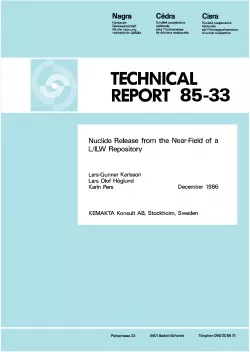
Technical Report NTB 85-33
Nuclide Release from the Near-Field of a L/ILW Repository
For Project Gewähr 1985, the release of nuclides from a repository for low- and intermediate-level radioactive waste is calculated. The calculations are made for a reference design repository located in the marl host rock at the Oberbauenstock reference site. The results are limited to the release of the nuclides from the waste through the engineered barriers into the surrounding host rock and will, therefore, constitute a source term for the far-field and biosphere calculations.
The most probable nuclide transport mechanism is diffusion and releases are thus influenced by the nuclide diffusivities in the barriers, nuclide sorption and nuclide solubility limits. Degradation of the engineered concrete barriers is taken into account. The effects of convective flow through the barriers are described elsewhere.
A near-field release model is presented. It consists of a set of computer programs suited to handle different repository designs, solubility limitations and the different waste categories.
The release calculations were made for a base case in which best estimates of the parameters were used. Sensitivity to the choice of the most important parameters was tested by parameter variations. The numerical models used were checked by comparative calculations with different codes and similar data.
The results of the base case calculations show that near-field barriers will cause both a delay of the release to the far-field and a reduced rate of release.
The sorbed nuclides, comprising the actinides and some activation and fission products, will be delayed by 10'000 years and have a maximum release rate of less than 10-3 Ci/a each. The non-sorbed nuclides are delayed by only about 100 years and the maximum release rate is less than 10-2 Ci per year and nuclide.
The parameter variations and the design model tests gave only limited deviations from the base case results.
